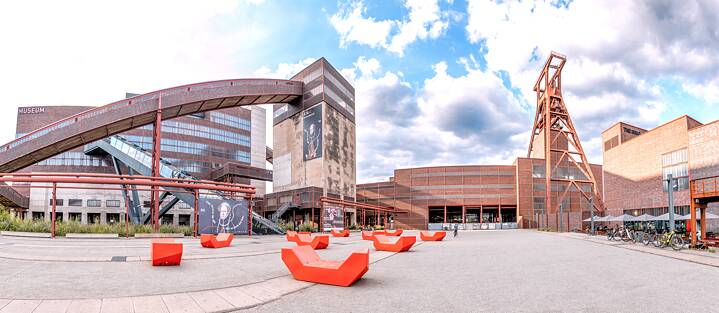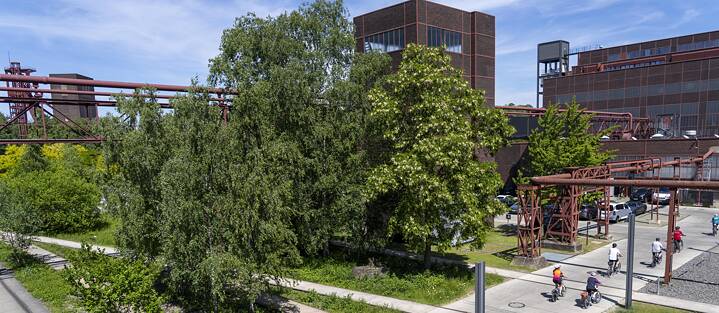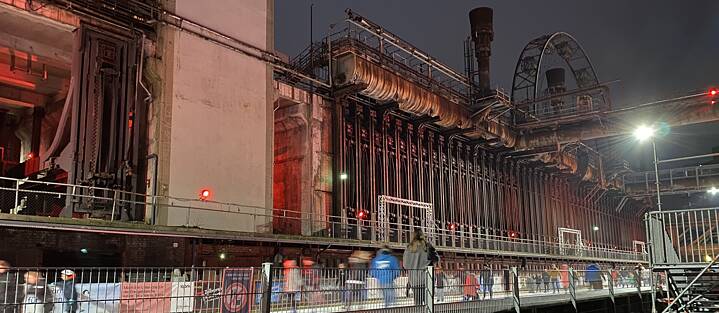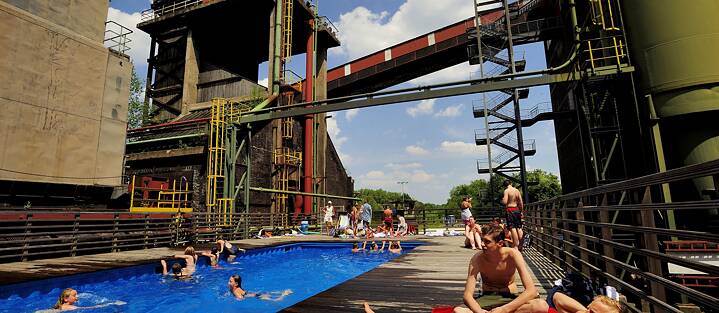Detours | Zollverein Coal Mine
The Eiffel Tower of Industrial Culture

Can a disused coal mine be beautiful? Zollverein coal mine in Essen can! The Zollverein industrial complex combines architecture and nature, culture and leisure activities, the past and the future. Anyone into ice skating or swimming will definitely have a great time here.
By Alina Schwermer
The disused Zollverein coal mine in Essen has been part of a UNESCO World Heritage site since 2001. Covering an area of some one hundred hectares, it combines art and industry: with its iconic red twin pithead winding tower, affectionately dubbed the “Eiffel Tower of the Ruhr”, its listed Bauhaus architecture and monumental, diagonally ascending conveyor belts, its old machinery and colourful light installations. It is even advertised as the “world’s most beautiful coal mine”. But does it live up to the hype? Come and decide for yourself, as today it is the beating heart of the local cultural landscape, featuring guided tours, art exhibitions, sports facilities, dance events and festivals. You can even discover wetlands full of frogs and newts while strolling through the parks that surround the mine and coking plant.
That said, Zollverein coal mine has something of an inglorious history: here in the north of Essen, millions of tonnes of coal were extracted from the ground between 1851 and 1986, with devasting consequences for nature, humans and the climate. Though often romanticised these days, the “pitmen” at Zollverein coal mine for the most part endured catastrophic working conditions. Prisoners of war and forced labourers also suffered immensely here during the Second World War.
While the coal mine has ceased operations, the mining of raw materials worldwide is far from over. But the former Zollverein coal mine has become an example of how heavy industrial sites can become spaces for the future. Not only can you learn a great deal about the history of coal here – the world’s largest exhibition of contemporary design also boasts all kinds of hands-on experiences: in the “Palace of Projects”, for instance, you can step inside utopian visions of a better world or take part in a workshop to create one yourself. Or give free rein to your creativity during an art workshop at the ARKA cultural venue. The Zollverein complex features a parkour facility, concerts ranging from classical music to techno, an open-air cinema, cycle paths, restaurants, an ice rink in the winter and a spectacular viewing platform.
Once the world’s biggest coal mine, Zollverein now attracts around 1.5 million visitors a year. And if culture doesn’t happen to be your thing, how about this: Zollverein has one of Germany’s most unusual swimming pools, nestled between gigantic pipes and industrial stairways, where you can splash around to your heart’s content completely free of charge!
Detours
What does Görliwood mean, why can you find a piece of the Caribbean in Bavaria and where can you dance in front of bucket wheel diggers? In our series we take you on a trip each month to somewhere in Germany that you may not yet know but should definitely be introduced to. We reveal places that are not to be found on the usual tourist trails. Are you ready for a bit of a detour?



